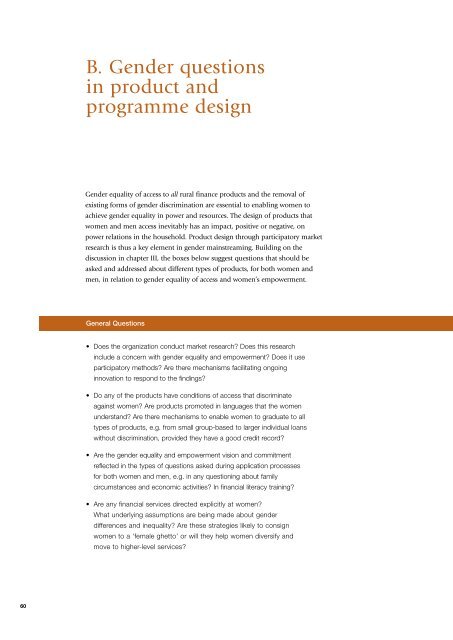Gender and rural microfinance: Reaching and empowering ... - IFAD
Gender and rural microfinance: Reaching and empowering ... - IFAD
Gender and rural microfinance: Reaching and empowering ... - IFAD
You also want an ePaper? Increase the reach of your titles
YUMPU automatically turns print PDFs into web optimized ePapers that Google loves.
B. <strong>Gender</strong> questions<br />
in product <strong>and</strong><br />
programme design<br />
<strong>Gender</strong> equality of access to all <strong>rural</strong> finance products <strong>and</strong> the removal of<br />
existing forms of gender discrimination are essential to enabling women to<br />
achieve gender equality in power <strong>and</strong> resources. The design of products that<br />
women <strong>and</strong> men access inevitably has an impact, positive or negative, on<br />
power relations in the household. Product design through participatory market<br />
research is thus a key element in gender mainstreaming. Building on the<br />
discussion in chapter III, the boxes below suggest questions that should be<br />
asked <strong>and</strong> addressed about different types of products, for both women <strong>and</strong><br />
men, in relation to gender equality of access <strong>and</strong> women’s empowerment.<br />
General Questions<br />
• Does the organization conduct market research? Does this research<br />
include a concern with gender equality <strong>and</strong> empowerment? Does it use<br />
participatory methods? Are there mechanisms facilitating ongoing<br />
innovation to respond to the findings?<br />
• Do any of the products have conditions of access that discriminate<br />
against women? Are products promoted in languages that the women<br />
underst<strong>and</strong>? Are there mechanisms to enable women to graduate to all<br />
types of products, e.g. from small group-based to larger individual loans<br />
without discrimination, provided they have a good credit record?<br />
• Are the gender equality <strong>and</strong> empowerment vision <strong>and</strong> commitment<br />
reflected in the types of questions asked during application processes<br />
for both women <strong>and</strong> men, e.g. in any questioning about family<br />
circumstances <strong>and</strong> economic activities? In financial literacy training?<br />
• Are any financial services directed explicitly at women?<br />
What underlying assumptions are being made about gender<br />
differences <strong>and</strong> inequality? Are these strategies likely to consign<br />
women to a ‘female ghetto’ or will they help women diversify <strong>and</strong><br />
move to higher-level services?<br />
60

















